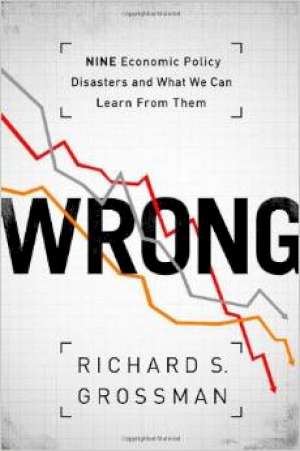16 January 2015
Wrong
Nine economic policy disasters and what we can learn from them
Richard S. Grossman
2014, Oxford University Press, 272 pages, £18.99
ISBN 9780199322190
Reviewer: James Howatt, Capital Economics

Since 2008, the world economy has often seemed in a state of perpetual crisis. So Richard Grossman, an Economics professor at Wesleyan University, has written a welcome jaunt through nine past economic crises in order to tease out some common policy-making missteps that lead to disaster.
Amongst these mistakes, Grossman identifies political institutions that promote narrow vested interests over the public good. For example, the US’s 1930 Smoot-Hawley tariff – which contributed to the collapse in global trade during the Depression – was the product of congressional horse-trading in smoke-filled rooms, an environment that hardly favoured a cool analysis of the national interest. And powerful groups often delay or paralyse the policy-making process. After Japan’s bubble burst in 1991, the domineering Ministry of Finance – its powers ranged from fiscal policy to bank supervision and some aspects of monetary policy – was able to cover up the scale of the country’s banking crisis, and its complicity in it. Japan ultimately took 8 years to strengthen its banks, extending and deepening its economic slump.
The book’s biggest bugbear is policy driven by the ‘big idea’. The UK, perhaps surprisingly, provides many of the examples of such ideological policy-making. Most bracingly, Grossman shows how Britain’s refusal to interfere in food markets in the name of free trade exacerbated Ireland’s potato famine in the 1840-50s, a period in which the country’s population fell by nearly a quarter. And after WWI, the British government convinced itself that returning to the gold standard at the pre-war rate was central to restoring Britain’s place in the world. With notable exceptions such as Keynes, this view was ‘common sense’ in much of the Establishment.
Taken together, Grossman’s three policy-making mistakes are fairly uncontroversial – most can surely agree that decision-making should not be corrupt, slow or ideological. And Grossman might sometimes have probed a little deeper into links between these problems, such as how powerful groups are often necessary to sustain nefarious ‘big ideas’. For example, in the chapter about the US’s series of short-lived central banks in the 19th century, it is unclear to what extent opposition to a central bank was motivated by principled anti-federalist ‘ideology’, rather than by private banking interests that manipulated these arguments for their own ends.
Nonetheless, this is an interesting and sometimes insightful work of economic history. Each crisis is well explained and contextualised within 20 pages. I particularly enjoyed learning about the origins of Japan’s bubble in the financial deregulation that followed the oil crises of the 1970s. And Grossman writes with an eye for the revealing fact. For instance, without a central bank to smooth out seasonal changes in the money supply, US financial crises often happened in the autumn when the harvest drained currency from major cities. What’s more, given that each chapter is self-contained, this fairly short book is easy to dip in and out of.
Grossman concludes that, while we might eventually learn specific lessons from the recent batch of crises – banks might become better regulated, perhaps – the allure of the next ‘big idea’, and the powerful groups peddling it, are guaranteed to lead us astray again.
